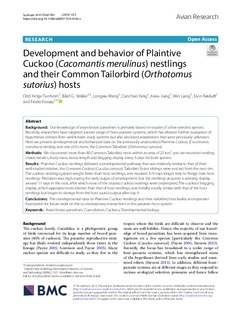| dc.contributor.author | Tunheim, Odd Helge | |
| dc.contributor.author | Stokke, Bård Gunnar | |
| dc.contributor.author | Wang, Longwu | |
| dc.contributor.author | Yang, Canchao | |
| dc.contributor.author | Jiang, Aiwu | |
| dc.contributor.author | Liang, Wei | |
| dc.contributor.author | Røskaft, Eivin | |
| dc.contributor.author | Fossøy, Frode | |
| dc.date.accessioned | 2019-09-24T11:41:47Z | |
| dc.date.available | 2019-09-24T11:41:47Z | |
| dc.date.created | 2019-01-21T10:42:31Z | |
| dc.date.issued | 2019 | |
| dc.identifier.citation | Avian Research. 2019, 10 (5) | nb_NO |
| dc.identifier.issn | 2053-7166 | |
| dc.identifier.uri | http://hdl.handle.net/11250/2618490 | |
| dc.description.abstract | Background
Our knowledge of avian brood parasitism is primarily based on studies of a few selected species. Recently, researchers have targeted a wider range of host–parasite systems, which has allowed further evaluation of hypotheses derived from well-known study systems but also disclosed adaptations that were previously unknown. Here we present developmental and behavioral data on the previously undescribed Plaintive Cuckoo (Cacomantis merulinus) nestling and one of its hosts, the Common Tailorbird (Orthotomus sutorius).
Methods
We discovered more than 80 Common Tailorbird nests within an area of 25 km2, and we recorded nestling characteristics, body mass, tarsus length and begging display every 3 days for both species.
Results
Plaintive Cuckoo nestlings followed a developmental pathway that was relatively similar to that of their well-studied relative, the Common Cuckoo (Cuculus canorus). Tailorbird foster siblings were evicted from the nest rim. The cuckoo nestlings gained weight faster than host nestlings, and required 3–9 days longer time to fledge than host nestlings. Predation was high during the early stages of development, but the nestlings acquired a warning display around 11 days in the nest, after which none of the studied cuckoo nestlings were depredated. The cuckoos’ begging display, which appeared more intense than that of host nestlings, was initially vocally similar with that of the host nestlings but began to diverge from the host sound output after day 9.
Conclusions
The developmental data on Plaintive Cuckoo nestlings and their tailorbird host builds an important foundation for future work on the co-evolutionary interactions in this parasite–host system. | nb_NO |
| dc.language.iso | eng | nb_NO |
| dc.publisher | BioMed Central | nb_NO |
| dc.rights | Navngivelse 4.0 Internasjonal | * |
| dc.rights.uri | http://creativecommons.org/licenses/by/4.0/deed.no | * |
| dc.title | Development and behavior of Plaintive Cuckoo (Cacomantis merulinus) nestlings and their Common Tailorbird (Orthotomus sutorius) hosts | nb_NO |
| dc.type | Journal article | nb_NO |
| dc.type | Peer reviewed | nb_NO |
| dc.description.version | publishedVersion | nb_NO |
| dc.source.volume | 10 | nb_NO |
| dc.source.journal | Avian Research | nb_NO |
| dc.source.issue | 5 | nb_NO |
| dc.identifier.doi | 10.1186/s40657-019-0143-z | |
| dc.identifier.cristin | 1662000 | |
| dc.description.localcode | Open Access This article is distributed under the terms of the Creative Commons Attribution 4.0 International License (http://creativecommons.org/licenses/by/4.0/), which permits unrestricted use, distribution, and reproduction in any medium, provided you give appropriate credit to the original author(s) and the source, provide a link to the Creative Commons license, and indicate if changes were made. | nb_NO |
| cristin.unitcode | 194,66,10,0 | |
| cristin.unitname | Institutt for biologi | |
| cristin.ispublished | true | |
| cristin.fulltext | original | |
| cristin.qualitycode | 1 | |

